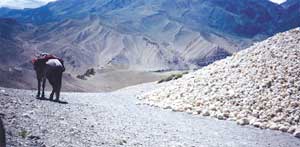 Here in the Himalayan rainshadow, the land is arid and surrounded by rugged mountains. This is also a place rich in history and culture, which have combined to make this a part of modern Nepal's diversity. The walled town of Lo Manthang is the capital of Mustang and houses the monastery and the king's palace. Five hundred years ago, the monastery was moved to the valley from a nearby hilltop to make it easier for citizens to travel.
Here in the Himalayan rainshadow, the land is arid and surrounded by rugged mountains. This is also a place rich in history and culture, which have combined to make this a part of modern Nepal's diversity. The walled town of Lo Manthang is the capital of Mustang and houses the monastery and the king's palace. Five hundred years ago, the monastery was moved to the valley from a nearby hilltop to make it easier for citizens to travel. Today, a road from the Tibetan border to Lo Manthang will also make it easier for trade and commerce. But the road has triggered a controversy. The Annapurna Conservation Area Project, the District Development Committee and the Village Development Committees are all looking for alternatives to the road. King Jigme Prabal Bista has also appealed for the conservation of his walled capital.
But locals are happy with the road because it makes daily necessities and food easier and cheaper. After democracy, candidates for elections have all promised a road. But it was only in the last two years that the DDC and the local people completed a 20 km road from the Chinese border at Korala Pass to Lo Manthang. Chinese lorries now regularly ply back and forth. Each of the six VDCs in the area contributed Rs 352,000 each and the road has been gravelled. Local elected representatives and businessmen are all happy, and encouraged that there will now be a boom in trade between Nepal and China. They even want to extend the road down south to Thak Khola to meet the road coming from Beni up the Kali Gandaki.
Every week up to five big Chinese trucks leave Tudum Bazar in Tibet, cross the Tsang Po (Brahmaputra) and enter Nepal with goods for sale here. The Chinese traders who bring the trucks camp outside Lo Manthang for a week and conduct up to Rs 6 million worth of business. What they bring is mostly cement, but also, sadly, Nepali timber is smuggled from Manang and Larkya into Tibet and re-exported into Nepal. This sudden availability of timber and cement means that there is now a construction boom outside the walled city. However, the trucks go back to China empty-there is nothing much to export from the Nepali side. Trade here is one-sided.
All along the road from Lo Manthang to the border, there is no sign anywhere of the presence of His Majesty's Government of Nepal. There are two customs sheds in Nechung, but there is no one inside them. In a way you could say this is what "free trade" means-no interference at all from government. The only tax the trucks will pay is the road toll that the DDC may soon introduce with powers from the Local Self-Governance Act.
There is also concern about what the road will do to Mustang's tourism industry. So far the ACAP has been using a model of "low volume, high spending" tourism for Mustang. The road could change all that: there could be large numbers of tourists driving up to Mustang from the Tibet side or from Jomsom, once the southern road is completed. Trekkers who presently need two weeks to walk through Mustang from Jomsom and back will be able to do it in a few days. Businessmen from lower Mustang would use the road and drive local traders in Lo Manthang out of business.
There is another proposal to build an airport at Charang to connect the road from the Chinese border, and connect the airport to Lo Manthang by cable car. This would minimise the negative environmental and cultural impact of the road.
Tourists interviewed in Lo Manthang all agreed that the road would destroy the fragile environment and culture of Mustang. They felt a sustainable long-term tourism strategy was what was needed, not a road. Most foreign visitors agree.
The future of the unique heritage of Lo Manthang, it seems, is a concern of not just the Mustangis, but of the rest of Nepal, as well as the world. If Kathmandu looks at Mustang as just another of the 75 districts in Nepal, then the cultural and natural heritage of this region could be destroyed by the over-development that comes with the arrival of a highway. That is why before any decision is made on taking the Lo Manthang road southwards to join up with the road from Beni, a detailed masterplan needs to be mapped out. We need to do it right away before we lose more of Mustang's precious heritage.


